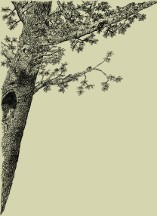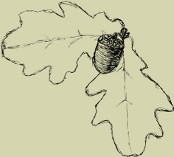42 41 40 39 38 37 36 35 34 33 32 31 30 29 28 27 26 25 24 23 22 21 20 19 18 17 16 15 14 13 12 11 10 9 8 7 6 5 4 3 2 1
Zeszyt 19 (1989)
The shortage of wood caused the interest in black locust wood. There is only little data available in the literature concerning the working properties of this species. Therefore it was decided to determine the specific work of free cutting in longitudinal and transversal directions for this wood. Measurements were performed using a pendulum-type laborometr and a multiple cutting principle was observed.
It was found that mean numerical values of specific cutting work in free cutting were 38 MJ/m3 for longitudinal cutting and 18 MJ/m3 for transversal cutting. On the basis of the data, the specific cutting work coefficient cr was calculated: the mean value of this coefficient is 1.9.
It was also established that the specific cutting work depends on the share UF of latewood. This dependence can be described by the formula: k = 0.34 UF + 15 (MJ/m3).
Relationship between the specific work P/b of cutting and the thickness g of chip is presented by the following equations: P/b = 13.1 g + 1.19 (kN/m) for g ≤ 0.1 mm and P/b = 4.1 g + 2.12 (kN/m) for 0.4 mm ≥ g ≥ 0.1 mm in transversal cutting and P/b = 35.0 g + 1.32 (kN/m) for g ≤ 0.1 mm and P/b = 11.9 g + 3.89 (kN/m) for 0.4 mm ≥ g ≥ 0.1 mm in longitudinal cutting.
It was attempted to establish the payability of pine, spruce, beech, oak an alder first quality group sawlogs conversion in to sawn materials and face-veneer. During experimental conversion the following final destination products were taken into account: export lumber, lumber for domestic use, lats, furniture half-products, parquet strips and face-veneer. Obtained results were used as a basis of economic calculus. Accumulation of capital rate was accepted as a fundamental criterion of sawlogs conversion optimization. Results of performed investigation are pointing to the necessity of selecting logs of highest quality from the rest of high grade sawlogs and use them for the production of face-veneer in the first place, and next for the production of furniture half-products and parquet strips.
Scots pine (Pinus sylvestris L.) wood derived from ship sunk in the Gdańsk Bay, which remained over 300 years in sea water, was investigated. Investigated wood was characteristic by annual rings of about 1.9 mm wide with 26% of latewood share on the average. Chemical analyses revealed not significant differences in the chemical composition in comparison with the contemporary pine wood with the exception of mineral substances and water-solubility. The share of sodium in the investigated wood was over ten times higher than in contemporary wood and solubility in cold water was respectively higher by 123%. Moisture content of wood from sea bottom corresponding the fibre saturation point was found to be three times higher than maximum hygroscopicity of contemporary pine wood's cell walls. The compressive strength along the fibres in wet state of wood from sea bottom was about 16% lower in comparison with contemporary wood of the same species.
The phenomenon of quasi-residual or frozen ability of wood to create deformations in considered. Results of experiments on deformations with heating or cooling with or without loading of wood are presented.
In the first part of the paper results of experiments concerning the pyrolysis of beech hydrolyzed with the application of water and 0.5% sulfuric acid solution. Not hydrolyzed beech bark was used in experiments as comparable material. Fundamental physio-chemical properties of raw material such as: elementary composition, chemical composition, and thermal properties were determined. On this basis cackles of raw materials thermal disintegration were carried out using following technological parameters: final temperature 673, 773, 873 and 973 K; time of heating 180 min.; rate of temperature rising 0.05 K/s. Material balance of the process was performed and solid products of the pyrolysis were investigated with particular regard to their porous structure. It was found that products obtained from hydrolyzed bark differ widely, as far as their composition and properties are are concerned, from pyrolysis products obtained from not hydrolyzed material. Their behavior in the course of thermal decomposition both favorable activation energy as higher by about 15% yield of pyrolysis process as well as porous structure of obtained products are justifying the conclusion that pyrolysis products obtained from hydrolyzed beech bark can be used as a raw material for the production of active carbon. It can be added here that granules subjected to pyrolysis were prepared without the addition of foreign bonding substances.
Impurities in pulp are preveilingly scraps from the boundary line of the advanced stage of wood decay. In these lines the fungal hyphae create pseudoscleritia which are highly resistant to the cooking process in pulp production. The different structures of pseudosclerotia in the determined fungi species on some important timber species has been confirmed.
Investigations on the effect of storage time of three kinds of chips stored in thermal insulated containers of 0.16 m3 capacity on the moisture content of wood its density, weight losses, and the dynamic modulus of rigidity were carried out. It was found that the increase in chip temperature during storage results in an intensification of degradation processes, expressed in evident staining and weight losses. A further confirmation of those processes provides the increase in sorptional ability of wood. The degradation processes occurring lead to deterioration of wood internal bonds expressed in a decrease of the dynamic modulus of rigidity after a lapse of 190 days, ranging from 2.8% to 18.2%.
The effect of ozone treatment parameters (charge of ozone, initial pH, time) of groundwood from spruce on the development of the process and properties of pulp was investigated. The increase of wet strength as high as 60% and over 30% of breaking length was stated when the groundwood was treated with 1-3% of ozone.
The removal of lignin from groundwood treated with ozone was accompanied by the decrease in brightness which mainly depended on the initial pH of reaction.
The mechanism of brightness changes occurring in groundwood during ozonization was investigated using IR and visible spectroscopic method, ART-technique.
The optimum parameters of ozone treatment of groundwood from spruce were found as followed: charge of ozone — to 2%, initial pH 7, time — 30 minutes.
Interrelations between chemical and morphological factors of fibers and properties of kraft pulps were investigated for pine and beech wood.
It was stated, that the yield of pulp depends above all on the ratio of cellulose content to the sum of lignin and extractive content. Sheet density, breaking length an burst factor depend considerably on fiber cross dimensions, especially on cell wall thickness and some of its characterizing indices. Tear and folding resistance depend both on cross dimensions of fibers and of their length.
Scots pine and beech wood was decayed by the Coriolus versicolor fungus. It was observed that the pine wood is darkening from 80 to 54% while the beech wood revels increase of brightness from the 57 to 80%. The mentioned observations were found in two experimental repetitions. Any influence of such factors as access of daylight in the course of decay or degree of extraction of resinous substances on the changes of colour was not stated. About three times increase of relative content of substances soluble in NaOH was observed in Scots pine, while those changes were slight in decayed beech wood.















 Pobierz PDF
Pobierz PDF